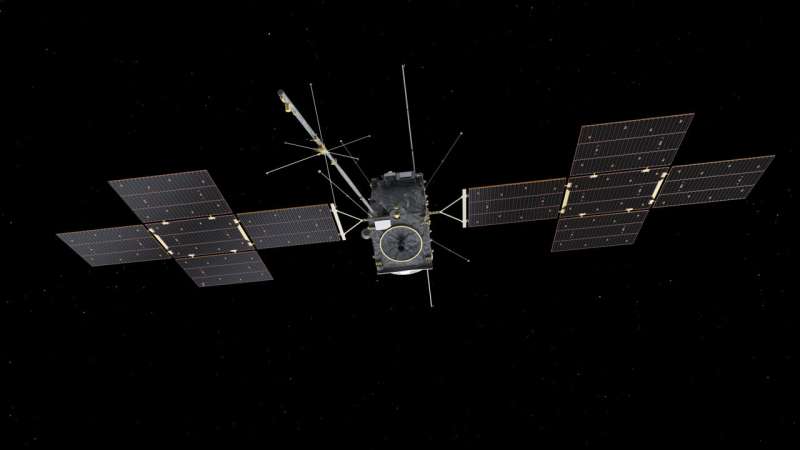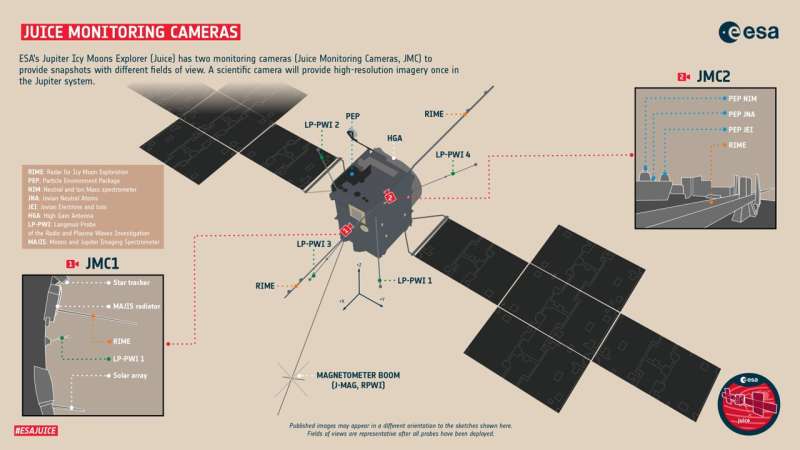
Flight controllers at ESA's mission control center in Germany have been busy this week, working with instrument teams on the final deployments to prepare ESA's Jupiter Icy Moons Explorer (Juice) for exploring Jupiter.
It has been six weeks since Juice began its journey, and in that time the Flight Control Team have deployed all the solar panels, antennas, probes and booms that were tucked away safely during launch. The last step has been the swinging out and locking into place of the probes and antennas that make up Juice's Radio & Plasma Wave Investigation (RPWI).
"It's been an exhausting but very exciting six weeks," says Angela Dietz, deputy spacecraft operations manager for the mission. "We have faced and overcome various challenges to get Juice into the right shape for getting the best science out of its trip to Jupiter."
We've had regular snapshots of the entire deployment process thanks to Juice's two onboard monitoring cameras, each with a different field of view. In the hours after launch, these cameras took Juice's first 'selfies' from space, and ever since, they have been vital for checking that all parts of the spacecraft deployed correctly.
Juice's antennas and booms each carry part or all of some of Juice's 10 instruments. By placing them far from Juice, the instruments that need to be separated from the spacecraft's own electric and magnetic fields are kept at a distance.
This powerful instrument package will collect data that helps us answer questions like: What are Jupiter's ocean worlds like? Why is Ganymede so unique? Could there be—or ever have been—life in the Jupiter system? How has Jupiter's complex environment shaped its moons, and vice versa? What is a typical gas giant planet like—how did it form, and how does it work?
Accompanying our views from the monitoring cameras, confirmation that everything deployed as planned also came from the instruments themselves. The teams behind some of the instruments have been switching them on and making measurements to check that everything is working well. Teams have already confirmed that Juice's RPWI, JANUS, J-MAG and GALA instruments, as well as the RADEM radiation monitor, are ready for Jupiter.
RPWI: Five days, seven deployments
This week, the four Langmuir Probes and three Radio Wave Instrument antennas of the Radio & Plasma Wave Investigation (RPWI) were successfully deployed. Altogether these make up seven of the 10 RPWI sensors that will measure the variations in the electric and magnetic fields around Jupiter, as well as radio waves and cold plasma.
After seeing the last boom deploy successfully this afternoon, principal investigator of RPWI, Jan-Erik Wahlund from the Swedish Institute of Space Physics said, "Fantastic, after more than 10 years of intensive work, we are finally ready for science discoveries!"
RPWI will be the first ever device to generate a 3D map of the electric fields around Jupiter. It will give us valuable information on how energy is transferred between Jupiter's enormous rotating magnetosphere and the large icy moons Ganymede, Callisto and Europa. This energy transfer drives, for example, the auroras on Ganymede and in Jupiter's upper atmosphere. The special sensitivity of RPWI to low frequencies means that it will be able to detect very weak electromagnetic signals from tides and currents within the sub-surface oceans of the icy moons.
Before and after each deployment, the RPWI team switched on the instrument to measure the difference made by each newly deployed sensor. Each one now collects data and delivers it to RPWI's onboard data processing unit, which sends the data down to Earth.
"Our 3D design strategy makes it possible to measure true physical observables, such as energy and momentum, without resorting to theories or simulations to interpret the data," says Jan Bergman, a researcher at the Swedish Institute of Space Physics and technical manager for RPWI.
For more details on RPWI deployments, see the Swedish National Space Agency website (scroll down for English).

JANUS: First images taken in space
Last week, when Juice was about 8 million km from Earth, engineers switched the JANUS optical camera instrument on for the first time. Unlike the RPWI sensors mounted on booms far from Juice's main body, JANUS is fixed to an optical bench; this means that it is kept stable when pointing towards its targets—like using a tripod here on Earth. JANUS also points in the same direction as Juice's other "remote sensing" instruments.
At Jupiter, the JANUS camera will take images in 13 different colors, from violet light to near infrared. These images will allow scientists to investigate the moons Ganymede, Callisto and Europa, including studying whether life could exist below their icy crusts. JANUS will also collect data on other parts of the Jovian system, including the intense volcanic activity on Io, the many smaller moons, and Jupiter's faint ring system. Last but not least, JANUS will image processes taking place in Jupiter's atmosphere.
During last week's commissioning, a full hardware check was undertaken, with all subsystems activated and monitored. The performance of the instrument was checked by taking images of stars.
"The acquired data demonstrate that everything was nominal. After this intense on-ground session, we can say, we have a (fully commissioned) instrument!" says Pasquale Palumbo (IAPS-INAF), principal investigator of JANUS.
For more details see the website of the Italian National Institute for Astrophysics.
RIME: A sticky situation, finally unstuck
The journey to full deployment has not been entirely smooth sailing. Just a few days after launch, flight controllers attempted to unfurl the Radar for Icy Moon Exploration (RIME) instrument antenna. The first segments of the antennas unfolded as planned, but the next segments refused to budge.
Controllers suspected that a tiny stuck pin jammed the segments in place. They put their heads together to figure out a solution. They shook Juice using its thrusters. They warmed Juice using sunlight. Every day the antenna showed signs of movement, but stayed stuck in its bracket. Finally, RIME was jolted into life almost three weeks later, when the team fired a mechanical device inside the bracket. The shock moved the pin by a matter of millimeters. To the relief of ESA operations and project teams as well as industry, the antenna fully unfolded.
Commissioning of RIME is still ongoing, but the team has already made some measurements with the instrument.
What's next for Juice?
In the next weeks, more of Juice's 10 instruments will be switched on and checked, with the hope that by mid-July, all instruments will be working perfectly, ready for cruising to Jupiter.
In August 2024, Juice will carry out the world's first ever lunar-Earth gravity assist. By performing this maneuver—a gravity assist flyby of the Moon followed just 1.5 days later by one of Earth—Juice will be able to save a significant amount of propellant on its journey.
Provided by European Space Agency
Citation: Juice's final deployments complete: Ready for study of Jupiter (2023, May 29) retrieved 29 May 2023 from https://ift.tt/B2aZAz0
This document is subject to copyright. Apart from any fair dealing for the purpose of private study or research, no part may be reproduced without the written permission. The content is provided for information purposes only.
"complete" - Google News
May 29, 2023 at 11:36PM
https://ift.tt/JWfdm2u
Juice's final deployments complete: Ready for study of Jupiter - Phys.org
"complete" - Google News
https://ift.tt/oNzpZ0T
https://ift.tt/DAcmENK
Bagikan Berita Ini














0 Response to "Juice's final deployments complete: Ready for study of Jupiter - Phys.org"
Post a Comment